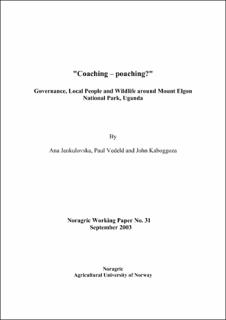| dc.description.abstract | This paper explores traditional hunting practices and institutions in the Mt. Elgon area of Uganda, local people's attitudes toward wildlife and their perceptions of conservation and co-operation with park staff. It also assesses the costs for local people of living with wildlife.
Data were collected through 100 household interviews and group discussions with hunters and elders from two ethnic groups, the Seabee and the Bagisu.
Results show that hunting is commonplace even if it is illegal. Local people hunt for food, for use of wildlife in circumcision ceremonies and to acquire cash income. They employ traditional hunting techniques such as snares, traps, spears, arrows and dogs. Bagisu hunters enjoy direct benefits from hunting inside the Park, while the Sabei hunt outside the Park. Both ethnic groups reflect strong utilitarian attitudes towards wildlife, followed by dominionistic and aesthetic attitudes. The attitudes are not found to vary by ethnic group nor are they dependent on gender. Perceptions of wildlife conservation and co-operation with the park staff are found to depend on three socio-economic factors: ethnic group, household size and village. The hunting is organized in social groups, with each their own particular values and norms for behaviour. The paper shows that wildlife hunting can be understood as a social institution with its distinct social values, norms and rules for behaviour.
The people of Mt. Elgon incur substantial costs by living with wildlife, through agricultural loss, predation on livestock and threats to human life. Such costs, although subject to substantial uncertainty, account for around 20% of the average gross household income. Improvements in the institutional arrangements and a real co-operation between the park staff and the local people are fundamental if wildlife is to be managed successfully in the future.
Wildlife authorities should accept hunting as an important social institution and to develop good models for co-operation, rather than the present futile banning approaches. An important suggestion is to treat wildlife similar to other forest resources, allowing communities to harvest goods and to exercise legal management rights, involving also controlled hunting of non-threatened species. This secures poor people direct access to important protein and cash generating resources It could, at the same time, drastically improve the battered relationship between government bodies and local people, thus serving as an example of improved governance as local people meet wildlife authorities in a context of positive or constructive every day “state making”. | en_US |
